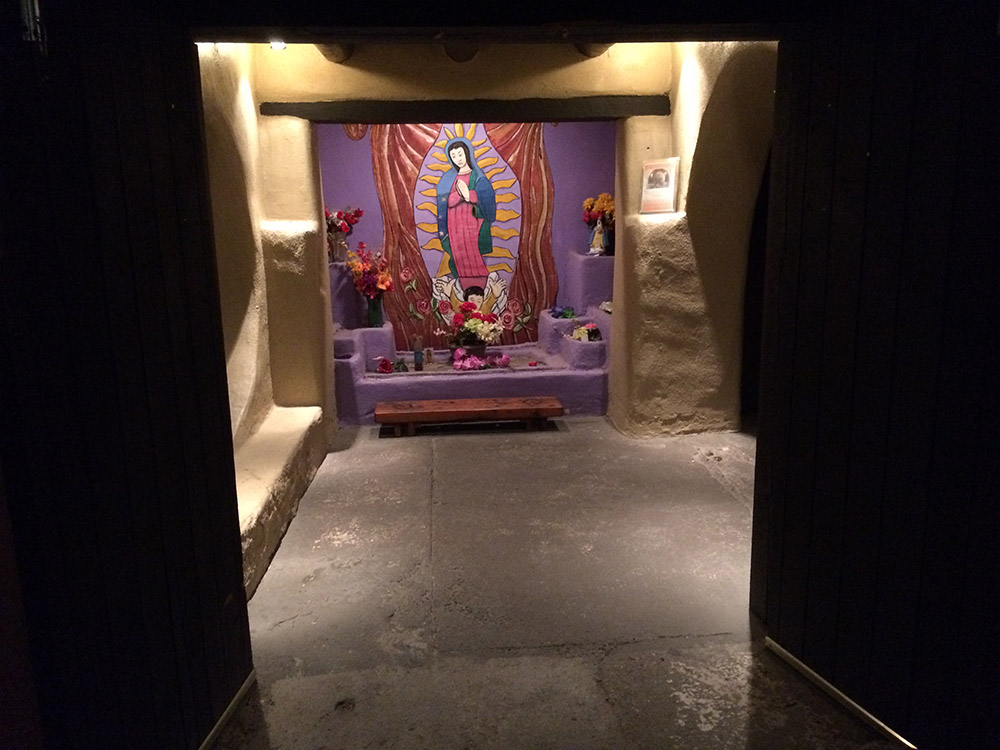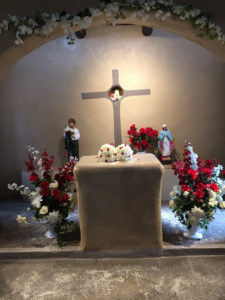Sister Giotto was the person responsible for designing and building La Capilla de Nuestra Senora de Guadalupe, which was erected in 1975. It was part of a larger project, an art school which she had established in 1969. The Sagrada Arts School eventually consisted of studios, apartments, the chapel, and even a restaurant called Joseph’s Table.
Sister Giotto was born in 1927 and raised in Chicago where she attended high school at Chicago’s famous Art Institute. When she was 17, after listening to the boys coming home from WWII and praying for them daily, she had a conversion experience. She then entered a Dominican convent and studied in Florence, Italy eventually receiving her M.F.A. from Wisconsin. After returning to her alma mater in Florence, she held the position of Dean of the Art Department at Villa Schifanoia for 8 years.
In 1965, the Vatican urged that schools of sacred arts should be set up wherever possible and soon afterwards Sister Giotto got permission to set up such a school. She chose to come to New Mexico because “it had its own indigenous religious art…no other place has this.”
She found a piece of land north of Old Town Plaza that was owned by one of the investors in the Sheraton Old Town, Mr. Wolfson. She fixed up the property after getting a 30 year lease from Mr. Wolfson. He charged her rent of $1/year. Eventually she bought the property.
Part of the school incorporated the remains of an old fort: five rooms at the front of the 2-story apartments were a civil war era barracks. They became studios. Sister Giotto’s brother-in-law, George Sandoval, had a furniture building and woodworking shop where the High Noon now stands. She slept in his shop for a while, and then moved to the convent next to San Felipe church.
Finally, construction on the chapel was started. Volunteers did all of the work, many of them from Mexico. As construction on the chapel slowly continued, two unique incidents occurred in her favor. First, Mr. and Mrs. Kaiser from Tucson presented her a portfolio of Ansel Adams’ work. She sold it to the Smithsonian for $20,000. This gave her the money to finish the chapel.
Then, a man involved in the construction trade, Mike, was sitting in the bus station in Milwaukee, wondering what to do for the next year or two. He overheard 2 people talking about Sister
Giotto’s chapel, came to Albuquerque, and ended up finishing the chapel as well as the gift shop in front of it.
Just inside the chapel, on the left, is a beautiful calendar window. According to Sister Giotto, she wanted to show that contemporary art belongs in a traditional setting. It shows the Feasts of the Virgin and the phases of the moon.” The window consists of 3 plexiglass panels. The middle panel can be adjusted for any year, so that in effect it is a perpetual calendar.
The benches and inscribed tablets that adorn the main room of the chapel were done it Italy when she was living there by Meinrad Craighead. The Sister carved one of them herself, but the rest were done by Craighead. They were originally carved for a chapel in Italy, but for some reason could not be used there, so they were packed around a lithography press in a crate and shipped to Albuquerque Sister Giotto would ring the chapel bells every morning at 6:00 for prayers.
Afterwards they would share fresh bread that the Sister had baked in the restaurant. Although Sister Giotto had got a special dispensation to build the chapel, it was never actually consecrated by the Catholic Church. This explains why the capilla is maintained solely by volunteers.

